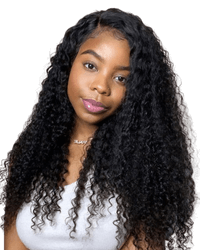Grasping the nuances of wig density can elevate your style game, ensuring that your wig doesn’t just sit atop your head but blends beautifully as if it’s sprouting from your very roots. Whether you prefer an understated aura of elegance or a lavish cascade of curls, understanding wig density is key to a harmonious hairstyle.
Let’s delve into the percentages that range from a subtle 50-60% to a luxuriously full 200% and beyond, and discover how these numbers can revolutionize your wig-wearing experience.
What is Wig Density?
When you’re looking to enhance your style with a hairpiece, understanding the concept of wig density is essential. It refers to the amount of hair hand-tied or sewn onto the wig cap, which dictates how the wig will ultimately frame your face and complement your look. Density is indicated as a percentage, influencing the overall hair wig volume, wig thickness, and fullness of the wig.
For a wig that melds seamlessly with your natural hair, aiming for a density similar to your own is advisable. The average density that most people choose is around 120%, which offers a balanced and realistic look. However, percentages can range from the delicate 50% for those who prefer a sparse presentation, to a luxuriant 200-250% density, favored by individuals desiring heightened volume and drama.
Hair Density VS Hair Thickness
Understanding the difference between hair density and hair thickness is key to choosing a hair wig that truly suits your needs. While both attributes contribute to the overall appearance of hair wig volume, they refer to distinct characteristics that can affect your wig choice.
Hair density is quantified by the number of individual hair strands on the wig cap. It is the prime factor that influences the wig’s lushness and fullness, impacting how voluminous the wig appears once it is worn. In contrast, hair thickness refers to the width of each strand of hair. This particular attribute dictates whether the hair is fine, medium, or coarse, but does not necessarily correlate with density.
You might encounter scenarios where your wig has a high density but with fine strands, or conversely, a wig that has thicker strands but a lower density. It’s this combination that gives each wig its unique look and feel. Here’s a simple breakdown to help you visualize:
| Hair Density | Hair Thickness |
| High number of hair strands | Width of individual strands |
| Impacts overall volume | Describes strand texture |
| Measured in percentages | Ranges from fine to coarse |
| Determines wig’s fullness | Influences the feeling of hair |
At first glance, one might be tempted to assume that density and thickness are one and the same, but the density will largely affect the hair wig volume, whereas thickness will dictate the tactile quality and individuality of each strand. So when you’re selecting your next hairpiece, consider both density and thickness to ensure you get the desired style and comfort.
- If you’re seeking a natural look that mirrors the average scalp, aim for a wig with medium hair density.
- In case you need a fuller look, gear towards high-density wigs.
- Remember, the thickness of the strands will add to the wig’s authenticity and should match with your personal preference or natural hair texture.
Whether you opt for a wig that offers a luxurious, thick canopy or one that boasts finer, more delicate strands, understanding the distinction between these two factors will lead you to a choice that elevates your style and confidence.
How Wig Density is Classified
Whether you’re dealing with thin hair and seeking volume and fullness or you’re exploring varied styling options for a glamorous look, understanding wig density classifications is key. Here’s how these categories shape your choices:
Low-Density
Perfect for a wholly natural impression, low-density wigs typically range from 50% to 100% density, making them the ideal match for those who have naturally thin hair or who yearn for a natural-looking hairline without excess volume. These wigs offer a conservative yet sophisticated fullness that doesn’t overwhelm, allowing for a seamless blend with your natural hair.
Medium-Density
When you desire a wig that delivers ample volume and yet maintains a natural appearance, medium-density wigs are the ideal middle ground. With densities between 130% and 150%, these wigs provide a happy medium, paving the way for various styling options and upgrades from a low-density choice. Their versatility makes them a staple in any wig collection.
High-Density
High-density wigs are the ultimate choice for those aiming for a dramatic and voluminous look. Boasting 180% to 250% density, these wigs ensure the maximum impact of volume and fullness. Beloved by influencers and celebrities, high-density wigs carve out the striking, glamorous looks that captivate audiences, yet they can still simulate an authentic hairline when selected and styled with care.
Wig Density Chart
Density percentages range from as low as 60%, offering a lighter and more natural look, to as high as 200%, where the hair is luxuriously full. By consulting this chart, you can visually gauge how thick or voluminous a wig might appear once worn, allowing for a more informed decision that aligns with your style or the look you are trying to achieve.
| Density Percentage | Appearance |
| 60-90% | Very Light, natural sparseness |
| 100-130% | Standard, similar to average hair fullness |
| 150-180% | Full, extra volume for a luxurious feel |
| 200% | Extra Full, for a glamorous, voluminous look |
How To Choose The Right Wig Density?
Every aspect of your wig, from texture to length, plays a part in creating an undetectable and flattering look. Here’s how each factor combines to help you find a wig that complements your face and lifestyle.
Face Shape
Your face shape is a fundamental starting point. A wig that complements your face will enhance your features, achieving a balanced and natural appearance. Assess whether a high-density wig could overwhelm your features or if added fullness might accentuate your face shape beautifully.
Your Natural Hair Density
To maintain a seamless transition, choose a wig density aligned with your natural hair. Hair thickness can vary throughout life, so consider current hair fullness for optimal compatibility.
Hairstyles You’d Like to Try
Think about the styling capabilities and hairstyle versatility that you crave. High-density wigs can support a wide range of glamorous hairstyles, while lower densities might be more suited for simpler, more natural looks.
Texture of the Wig
Wig texture greatly impacts perceived density. Curly textures can appear voluminous with less density, whereas straight hair may need additional density to avoid looking too flat. A wig’s fullness should match its texture for a professional, polished aesthetic.
Your Age
An age-appropriate wig takes into account the natural evolution of hair density. Older individuals might opt for lighter densities that mimic hair thinning associated with aging for a more believable profile.
Budget
Quality comes at a price, and high-density wigs often cost more. However, investing in a wig within your budget without compromising on the natural look is essential for your satisfaction and confidence.
Occasion
Consider the occasion and setting for your wig usage. More formal venues might call for high-density wigs that exude luxury and celebration, while daily wear might benefit from a more moderate density for comfort and natural ease.
Wig Length
Longer wigs may require greater density to ensure the strands provide fullness from roots to tips, avoiding a stringy appearance at the ends.
Ultimately, your decision should reflect a harmonious balance between personal comfort, the natural look you desire, and the ability to style your wig in ways that uplift and define you. Whether that means a subtle boost in volume or opulent hair thickness, the right density is out there, waiting to enhance your beauty and wig-wearing experience.
Wig Care for Different Densities
When it comes to wig maintenance, your approach can greatly influence the longevity and appearance of your hairpiece. Proper care is essential, not only to keep your wig looking its best but also to reduce shedding. Different densities of wigs may require slightly varied care techniques, but the foundation of wig care remains consistent across all types. Here’s a guide to help you preserve the quality of your wig at every density level.
Important tip: Always handle your wig with care, especially when washing or styling, to prevent unnecessary strain on the fibers that could lead to increased shedding.
| Density | Care Technique | Products to Use | Additional Tips |
| Low Density (50-100%) | Gentle washing, air drying | Mild shampoo, light conditioner | Use a soft-bristle brush for detangling |
| Medium Density (130-150%) | Regular maintenance, careful detangling | Moisturizing products for a natural sheen | Comb from tips to roots to reduce pulling |
| High Density (180-250%) | Knot sealing, secure storage | Knot sealer, hydrating sprays | Avoid excessive heat styling |
Regardless of the wig’s density, always utilize a knot sealer to lock in the hair strands after each wash. For those with a lace component, remember to handle the lace extremely gently to prevent any unnecessary tears or damage. Water temperature is also a crucial variable – always use lukewarm water during the washing process to prevent heat damage.
- Avoid heavy product build-up which can weigh down the wig and potentially increase shedding.
- For thinner wigs, minimal product is necessary. They’re typically more prone to appearing greasy or lanky if over-conditioned.
- Conversely, high-density wigs may require more frequent conditioning to maintain luster and manageability.
Conclusion
In the quest for finding the perfect wig, understanding the nuances of wig density can be the difference between a hairpiece that stands out awkwardly and one that radiates with effortless grace. It’s not just about how much hair is on your head, it’s about how harmoniously it blends with your unique features and style preferences. As you navigate through the myriad of choices, remember that a comprehensive wig choice transcends mere aesthetics; it’s about how it makes you feel – confident and comfortable.




